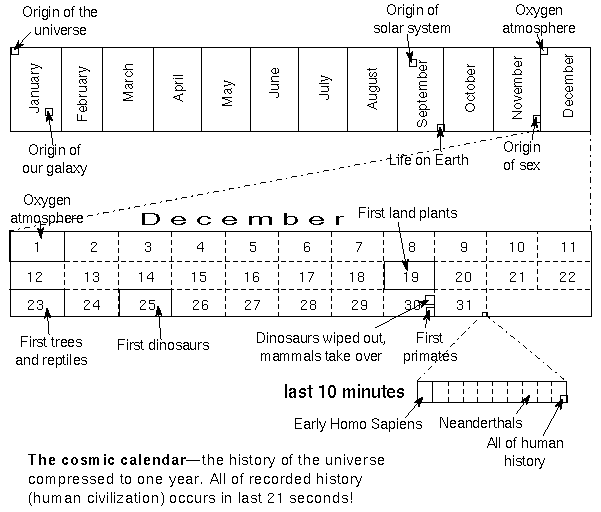
Video lecture for this chapter
Now let's try to get a feel for the time scales. I will use another scale model, but instead of reducing distances, I will shrink down time. The scale model is called the ``cosmic calendar'' in which every second in the ``cosmic calendar'' corresponds to 475 real years (so 24 cosmic calendar days = 1 billion real years). If you use the classical number of 15 billion years for the age of the universe, you can squeeze the universe's entire history into one cosmic calendar year (recent measurements place the age closer to 14 billion years). The universe starts in the early morning of January 1 at midnight in the cosmic calendar and our present time is at December 31 at 11:59:59.99999 PM in the cosmic calendar. Here are some important dates in this super-compressed cosmic calendar relevant to us humans: (see also the figure below)
| Origin of the Universe--Jan. 1 | Origin of our galaxy--Jan 24 |
| Solar system origin--Sept. 9 | Earth Solidifies--Sept. 14 |
| Life on Earth--Sept. 30 | Sexual reproduction advent--Nov. 25 |
| Oxygen atmosphere--Dec. 1 | Cambrian explosion (600 mil years ago when most complex organisms appear, fish, trilobites)--Dec. 17 |
| Land plants & insects--Dec. 19, 20 | First amphibians--Dec. 22 |
| First reptiles & trees--Dec. 23 | First dinosaurs--Dec. 25 |
| KT impact, mammal age, birds--10:00 AM Dec. 30 | First primates--Dec. 30 |
| Australopithicenes (Lucy, etc.)--10:00 PM Dec. 31 | Homo habilis--11:25 PM Dec. 31 |
| Homo erectus--11:40 PM Dec. 31 | Early Homo sapiens--11:50 PM Dec. 31 |
| Neanderthal man--11:57 PM Dec. 31 | Cro-Magnon man--11:58:38 PM |
| Homo sapiens sapiens--11:58:57 PM Dec. 31 | Human history--11:59:39 PM |
| Ancient Greeks to now--last five seconds | Average human life span--0.15 seconds |

It is rather surprising that we have been able to discover so much about the long term evolution of the universe and the things in it, especially when you consider that we have only been seriously observing the universe for about 100 years, which is only a very slight fraction of the universe's lifetime. About 100 years ago is when photography was first used in astronomy, making truly systematic observation programs possible. How can astronomers say that the Sun will go through a red giant phase in about 5 billion years from now with confidence? Is it hubris to confidently talk about the Earth's formation process 4.6 billion years ago?
To give you an idea of the difficulties in studying long timespans consider this analogy: An alien comes to Earth to search for life and to understand how it evolved. ET has a camera and has just 15 seconds to take as many photographs as possible. Fifteen seconds is the same proportion of a human lifetime as the 100 years is to the universe's age (15 seconds/human lifetime = 100 years/universe age). ET returns home and her colleagues try to understand Earth from this 15 second period of snapshots. They won't see any important evolutionary changes. How will they determine the dominant life form? They could use a variety of criteria: 1) Size: leads them to choose whales or elephants; 2) Numbers: choose insects; 3) amount of land space controlled by one species: choose automobiles.
Suppose they somehow decide humans are dominant. They now have further problems. There is considerable diversity among the humans (though to ET with 10 tentacles, 200 eyes, and a silicon outer shell, the humans all look alike!). ET and colleagues try to systematically classify the humans. The humans come in a variety of sizes. In a coarse classification scheme, they break the sizes down into small, medium, and large. They also come in variety of optical colors for their outer shell: red, black, brown, yellow, and white. There appears to be 2 separate sexes (ET is both male and female). After some false starts with theories that used hair length and eye color, they are ready to ask themselves, ``Do small, brown, female humans evolve into large, red, male humans?'' ``Do the small stay small and the large stay large?'' ``Why is there a tendency for small humans to be with one or two large humans?'' With the three characteristics [size (3 divisions), color (5 divisions), and sex (2 divisions)], ET has 3×5×2 = 30 different combinations and 30×30 = 900 possible evolutionary schemes to consider! Well, the universe has a lot more characteristics and, therefore, many more combinations to consider!
![]() Go back to previous section --
Go back to previous section --
![]() Go to next section
Go to next section
last updated: November 26, 2021